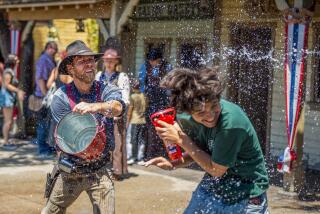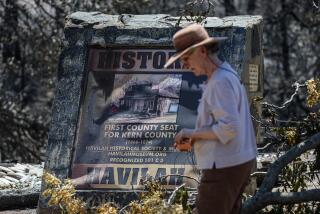Old haunts in two Arizona ghost towns
Half an hour after leaving Laughlin, Nev., our car pulled into this old ghost town. At the general store-visitor center, I read about intriguing murals painted on granite cliffs to the east -- 2,000 square feet of wildly colorful artistry in the stark Cerbat Mountains.
A shopkeeper said my new sedan would not survive the rutted dirt road to the murals. But then my brother, Roger, met a loquacious Chloride resident who said otherwise. Ruthie, decked out in baseball cap, jeans and her late husband’s pilot jacket, looked like an old-timer who knew the lay of the land. “Just take it slow,” she said. And so we did.
Had rain fallen recently, the drive would have been impossible without four-wheel drive. But the weather was fine, the road dry. I held the steering wheel tight, and into the Cerbat foothills we went.
Ruthie had not led us astray. Soon Roger and I were looking at “The Journey”: yin and yang symbols, an Egyptian princess, serpents, flames, celestial bodies and eagle’s talons hovering over a mining town. This was Nevada artist Roy Purcell’s 1966 work about self-discovery, painted on boulders not far from Indian petroglyphs.
Ruthie, the mural, the petroglyphs -- at first Chloride had seemed like a vision of eras past, but the town proved to be entertaining in its present. I’m a ghost-town junkie, and, like an optimistic gambler, I get excited every time I hit a jackpot like this. That’s why last February we chose Laughlin not as a gambling getaway but merely as a convenient base for visiting Chloride and Oatman.
We arrived at our Laughlin hotel on a Friday and were back on the road at dawn Saturday, driving about 40 miles to Chloride. Route 68 took us east through 3,600-foot Union Pass in the Black Mountains. The sun’s glow amplified the golden yellow of the rock and carved deep shadows in a surreal landscape. We turned north at U.S. 93 and continued into town, tucked off the highway on Tennessee Avenue.
At the Mineshaft general store and visitor center, the owner directed us to the back room, which had historical photos and pamphlets on town history. My favorite described a 1900 house fire that Western writer Louis L’Amour and others tried to extinguish with buckets. When the water ran out, L’Amour jumped off the roof and yelled to let the house burn.
Along Tennessee Avenue we passed Aggies Art Shack, a weathered building housing art, jewelry and gifts. Outside lay rusty farm implements, metal sculptures and any creation too large to fit inside.
We found much of Chloride -- home of painters, silversmiths, leather craftsmen and other artists -- to be similarly eclectic and artistic. Yards were decorated with junkyard-style monstrosities, welded sculptures incorporating discards such as barbecue grills, bicycle wheels, motorcycle gas tanks and bowling balls.
Intrigued by antique coffeepots in the window, we wandered into Parker’s Custom Saddles Etc., the shop of George and Armetta Parker, who design leather and rattlesnake products. The couple moved to Chloride from Wisconsin eight years ago. Their store was full of ambience, thanks to touches like the 120-year-old sewing machine that the Parkers still use to make saddles and harnesses. (The couple have since moved their shop to nearby Dolan Springs.) While George repaired a saddle, Armetta stopped her leather tooling to chat and to quote a price on a cowboy’s coffeepot, which Roger bought for $20.
We walked more side streets and admired historical buildings. Arizona Central Bank, painted a friendly yellow, and the BFGoodrich gas station, decked out in red and green and sporting two red pumps, are well preserved. The Chloride post office, built in 1871, is Arizona’s oldest still in operation.
The Chloride cemetery is striking, surrounded by hills, mining mounds and desert scrub. We walked through, noting gravesites ornately decorated with memorabilia left by loved ones: angel statues, motorcycle parts, ceramic pigs.
The soothing silence of the cemetery was in sharp contrast to Laughlin. Ca-ching, ca-ching, coins in, arm down, repeat. I lost $10 almost as soon as we stepped inside our hotel, the Laughlin Flamingo.
Roger’s luck ran hot playing video poker. Taking pity on me, he pushed over a handful of coins so I could play video blackjack near him. After I lost his money, I was left watching an Elvis-in-the-later-years impersonator on the lounge stage.
The Flamingo diner’s early-bird special one night, chicken and pasta, was no culinary feat. The only thing worth bragging about was the price: $1.99 per person.
Our room ($49 plus tax per night) had two comfortable double beds and a garden motif of green, red and pink -- an oasis in the desert.
A town built on mining
Our day trip to Oatman started with a drive to Kingman, where we walked through the Powerhouse museum and visitor center, full of Route 66 memorabilia.
From there, the highway took us though Sitgreaves Pass, a tortuous route through ochre and sienna mountains. It’s not for the fainthearted. Roger and I likened it to a roller coaster.
As Route 66 nears Oatman, the highway takes the name Gold Road, which is appropriate, considering the abandoned mines that line the way. Some are boarded up, but many have been left open. Old mines can be dangerous inside, so we just stopped and took pictures.
The mining frenzy started around 1900 with the Gold Road Mine east of Oatman, staked by José Jerez and Henry Lovin. Their claims led to extractions valued at about $2.25 million. Gold Road Mine was worked intermittently during the last century, finally ceasing production in 1998. Today daily guided tours are offered year-round, leaving every 30 minutes from 10 a.m. to 5 p.m. ([928] 768-1600, www.goldroadmine.com).
The town of Oatman sprang up with the Tom Reed Mine in 1904. As others sprang up, the town grew.
These days Oatman is a hoot. We caught the Oatman Ghost Riders, who stage shootouts on Route 66. Cowboys start yelling, guns start firing (blanks), the wounded fall to the road and the victor shouts that bad guys never win. For couples planning on getting hitched on Route 66, the Ghost Riders perform “Ol’ West Shotgun Weddings” (www.oatmanghostriders.com).
We roamed the streets along with burros, descendants of the ones prospectors used to haul supplies. Accustomed to being fed by tourists, the burros brazenly stick their heads into car windows and shopping bags.
Oatman only has about 250 residents, but that number swells with motorcyclists stopping on their way to or from Laughlin. Outside the Sugar and Spicey Gift Shop, a sign reads: “Harley parking only, violators will be terminated.”
The chamber of commerce holds an annual sidewalk egg-frying contest, an event shunned by Laughlin boosters who don’t like to point out the scalding summer temperatures. Every Labor Day there’s the Burro Biscuit Toss. Contestants see how far they can throw the “biscuits,” gold-painted clumps of hay that -- how shall we say -- have already flown through a burro.
We left Oatman on Route 66 and headed back to Laughlin. The trip took only 40 minutes, so I had plenty of time for a cheap prime rib dinner at the Edgewater Hotel and another chance to throw away cash in the casinos.
More to Read
Sign up for The Wild
We’ll help you find the best places to hike, bike and run, as well as the perfect silent spots for meditation and yoga.
You may occasionally receive promotional content from the Los Angeles Times.






